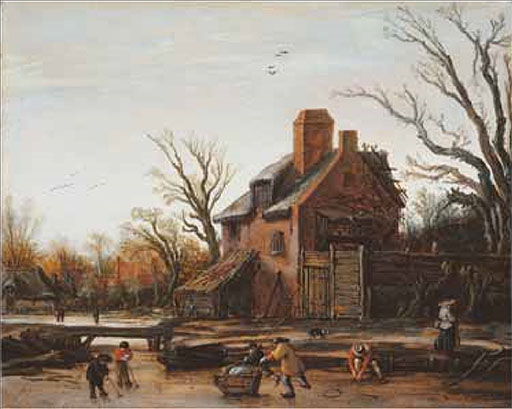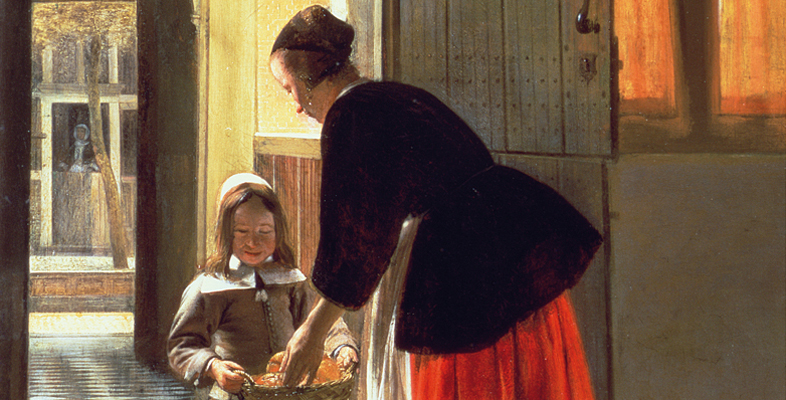6 Landscape painting and the limitations of the iconological approach
When de Jongh first drew the distinction between ‘realism’ and ‘seeming realism’ in his landmark essay of 1971, he was careful to point out that while he had found evidence of disguised symbolism in all the main types of Dutch seventeenth-century painting, including interior scenes, still life, portraiture and landscape, it would be wrong to assume that every painting of this period was ‘infused’ with hidden meanings. Other art historians have suggested that there may have been different degrees of disguised symbolism: whereas some artists, such as Jan Steen, made overt reference to moralising Dutch proverbs and emblem books, other artists, such as Vermeer, cloaked their ideas in forms that are harder to decode (Renger, 1978, pp. 12–13). However, given the extraordinarily varied and wide-range of subjects to be found in Dutch seventeenth-century painting, the question arises whether it is plausible to assume that artists working in different places and in different genres over such a long period could have been involved in the same basic enterprise. As Mariët Westermann puts it:
Could all these very different pictures, made by different hands, in very different styles, for very different eyes, possibly come down to the same moral essence? Were that plausible … was there nothing to distinguish these paintings, as paintings, from the prints, emblems, plays, treatises, and sermons used to gloss them?
The iconographic method is thus potentially reductive in at least two senses: not only does it presuppose that the great variety of Dutch painting possesses the same basic moralising content – itself often reducible to familiar homilies about the transience of worldly pleasures – it also appears to limit the interest we take in such paintings to their hidden moral message. In so far as the ‘meaning’ of a painting is treated as something that can be isolated from the form in which it is expressed, the painting itself becomes little more than a ‘vehicle’ for communicating ideas that could readily be found elsewhere. The iconographic method thus risks losing sight of those features of Dutch painting towhich Hegel had drawn attention, such as the artist’s ability to capture the play of light on different surfaces and the distinctive pleasure we take in the ‘appearance’ of an artwork. Although de Jongh and his colleagues claimed that the artist’s purpose was ‘to instruct and delight’, the iconographic method seems better equipped to explain the way in which a painting might ‘instruct’ the viewer rather than how it might serve as a source of pleasure.

A further problem with the disguised symbolism interpretation is that almost everything seems to be open to interpretation as a symbol of something else, making it very hard to determine whether a depiction of, say, a flower or rising smoke, was actually intended to be interpreted in a particular way. Consider, for example, the following passage from a book by the Dutch writer Levinus Lemnius published in 1587, in which he observes that a man’s life can be compared
to a Dreame, to a smoke, to a vapour, to a puffe of winde, to a shadow, to a bubble of water, to hay, to grasse, to an herb, to a flower, to a leafe, to a tale, to vanitie, to a weaver’s shuttle, to a winde, to dried stubble, to a post, to nothing.
Given this propensity to attribute symbolic meanings not only to natural phenomena (‘a puffe of winde’) but also to human inventions (‘a weaver’s shuttle’), it is possible that even paintings showing the most ordinary looking scenes might have been interpreted in symbolic terms. De Jongh, for example, suggests that Winter Landscape of 1624 by Esaias van de Velde (1587–1630) (Figure 20) refers to the ‘passage of the seasons’ and that ‘the waxing and waning of nature, could be seen as parallel to the course of man’s life from the cradle to the grave’ (Jongh, 1971, p. 27). His argument is not that we know for certain that the artist was inspired by this idea, but that we cannot exclude the possibility that contemporary viewers saw the painting in these terms: this realisation should give us pause for thought and prompt us to question the realist assumption that the painting is simply a faithful report of a scene viewed by the artist with no further significance.
De Jongh’s discussion of the ‘seeming realism’ of van de Velde’s Winter Landscape is carefully hedged with doubts and qualifications. By reminding the reader that seventeenth-century viewers may have been responsive to analogies and correspondences that are unfamiliar to us today, he provides an alternative interpretative framework that encourages us to consider the differences between the way in which we view the painting and the way it may have been viewed at the time. However, other art historians have applied the iconographic method to Dutch landscape paintings in a much more determinate way and have sought to identify a detailed programme of specifically religious symbols that can be decoded through reference to textual sources. The adoption of this approach by the art historian Joseph Bruyn in an essay published in the catalogue to an exhibition entitled Masters of Dutch Seventeenth-Century Landscape Painting, which was shown in both America and the Netherlands in 1988, awakened a great deal of controversy. For many art historians, Bruyn’s attempt to provide a ‘scriptural reading’ of landscape paintings by artists such as Jan van Goyen (1596–1656) and Jacob van Ruisdael (1628/29–82) proved a step too far, and it helped to stimulate critical reflection on the limits of the iconographical method.
As we might expect, Bruyn was able to identify plentiful textual sources in which, for example, a forest is presented as a symbol of sinful life or a river as a symbol of transitoriness. However, it is one thing to point to the prevalence of such symbols in treatises, sermons and emblem books, and another thing to establish that this provides the key to interpreting their appearance in a landscape painting. The theory seems to be self-confirming, for it is hard to conceive how any landscape painting could be produced that did not include things such as trees, rivers and hills, for these are the constituents of the landscape itself and thus always available for analysis in such terms.
